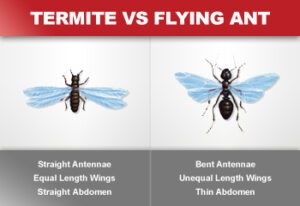What’s that you just spotted out of the corner of your eye? Was it just a baby fly? Perhaps a flying ant? Time to get out that can of fly spray. But what if it’s a flying termite? Is it a sign of a termite infestation? Is it time to panic?
Most people have heard horror stories about the thousands of dollars damage termites can do to your valuable home or asset. But few know what to look for when it comes to signs of a termite infestation. If you have spotted termites with wings around your property, you do have a potentially serious issue. That’s why we put together a list of do’s and don’ts when it comes to dealing with that oh-so-worrying of sights: termites with wings.
DO … take it seriously
Too many people see a tiny creature flying through the sky and think “Do termites fly? Of course, they don’t!” But they’d be dead wrong. While it’s true that it’s their offspring that do all the damage, it’s the breeding adults that have the wings and are therefore the easiest to spot.
DO … check the weather
While many other flying insects also love a balmy night, that is especially true for winged termites. It’s in warm, moist conditions that termites will typically spread their wings in the search for a new location to colonise.
DO … identify them correctly

Flying termites are commonly confused with flying ants because they’re about the same size and have four wings. But take a closer look at those wings in the illustration by Orkin – because all four of them are the same size sort of flying termites Australian households and businesses most fear, where the front wings are larger on flying ants.
Flying termites also have a straight antenna, and they’ll normally be on the move in a swarm. That’s why they’re commonly known as “swarmers” rather than the more technical term “alates”.
Related Reading: What You Need To Know About Termite Identification In Melbourne
DON’T … think spraying will solve your problem
So you spot that swarm, empty a can of fly spray on it, and you’ve solved your termite problem. Right? Definitely not! While that spray will kill them, you won’t kill the termites that are doing the damage in their old colony, or the new colony that those termites with wings are looking to establish.
DON’T … block their escape
If you’ve found where those flying termites are emerging from, it’s tempting to block the holes they have created for their escape. But don’t do that! Flying termites must find a way to escape, so if you block the holes they’ve already made they’ll just make new ones. Which means more damage to your place.
DON’T … stop your search
If you’ve spotted flying termites, your search has only just begun. The next thing you need to look for is the mud tubes, which are commonly seen in the garden near your home or around any wooden furniture. If you find these as well, you have an infestation.
DON’T … ignore it
Flying termites may not be a red-back spider or a brown snake in your home. But ignore them at your peril. They can absolutely destroy your home, so if you spot flying termites, it’s a sure sign you have a major problem. That colony needs to be found and completely destroyed … before your home is.
If you choose Cannon Pest Management, you can be sure we’ll not only sort your termite infestation but at the same time care about your hip pocket, family and pets with safe, effective and affordable Melbourne termite control treatments that really work. We proudly service suburbs like Ferntree Gully, Boronia, Heathmont, Bayswater, Healesville and well beyond.
Do you have a flying termite do or don’t that we haven’t covered? Got a termite infestation horror story to share? Anything else on your mind? We’d love to hear from you today.







